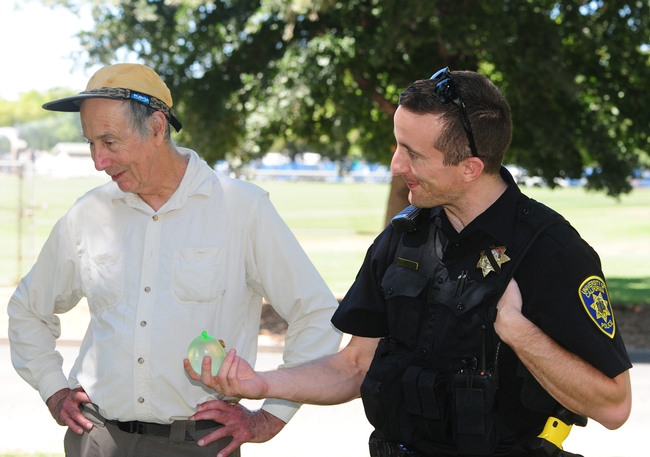
Well, if you're Bruce Hammock, distinguished professor of entomology with a joint appointment with the UC Davis Comprehensive Cancer Center, you annually host the Hammock Lab Water Balloon Battle on the Briggs Hall lawn.
He and research scientist Christophe Morisseau, coordinator of the event, are water warriors--the "Splash Brothers" counterpart to basketball superstars Steph Curry and Klay Thompson of the Golden State Warriors.
Their aim is as good the Curry/Thompson three-pointers.
Just call it 15 minutes of aim...and here's why.
Last Friday afternoon 40 participants, including professors, researchers, graduate students, staff, students and family members, tossed 3000 water balloons in 15 minutes on the thirsty lawn, as the temperature soared to 97 degrees. As the supply dwindled, they dumped the remaining water from the buckets on each other.
A highlight: “Splash Sister” Alifia Merchant of the Hammock lab, who just received her master's degree in agriculture and environmental chemistry, managed to sneak up on Hammock and drench him.
Hammock launched the annual event in 2003 as a form of camaraderie and as a means of rewarding the lab members for their hard work. The international Hammock lab includes 7 researchers, 9 postdoctorates, 3 graduate students, 10 visiting scholars, 3 staff and 1 undergrad. They represent Barbados, Canada, China, France, Germany, Hong Kong, India, Japan, Korea, Sweden, Thailand, Turkey, United States, Ukraine and Uruguay. Among those participating was Aldrin Gomes, associate professor in the Department of Physiology and Membrane Biology, and his lab.
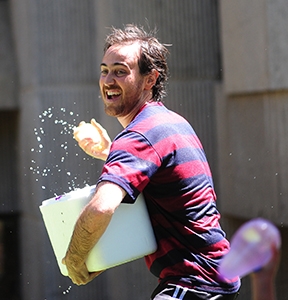
Hammock, a member of the National Academy of Sciences and a fellow of the National Academy of Inventors, directs the campuswide Superfund Research and Training Program, an interdisciplinary program funded by the National Institute of Environmental Sciences (NIEHS) that has brought in almost $60 million to the UC Davis campus. The Hammock lab is also the home of the National Institutes of Health Training Grant in Biomolecular Technology. The lab alumni, totaling more than 100 graduates, hold positions of distinction in academia, industry and government as well as more than 300 postdoctorates.
The “Balloon Battle at Briggs” was canceled last year due to the severity of the California drought. In 2014, the water warriors took drought-conservation precautions as they did this year.
“We devised a filling station out of drip line and valves so we could fill the balloons outside and also turn off the water when not in use,” said Hammock lab program manager Cindy McReynolds. “Water conservation was a big topic surrounding the (2014) event, so we also used it as an opportunity to discuss ways we have changed our daily routines to conserve water."
As an extra bonus, the annual battle provides a little water for the thirsty Briggs Hall lawn, which is used by campus wildlife, including ducks, turkeys, squirrels, birds, butterflies and bees.
(Editor's Note: Hammock, who received his doctorate in entomology at UC Berkeley in 1973, joined the UC Davis faculty in 1980. Although an entomologist, he is now involved more in human health--alleviating human pain--than he is with insect research. With Sarjeet Gill (now at UC Riverside) he discovered that the enzyme, soluble epoxide hydrolase (sEH), degrades fatty acid epoxides and plays an important role in human diseases. Hammock and his lab have developed inhibitors of sEH that are anti-inflammatory, anti-hypertensive, analgesic and organ-protective. Groundbreaking neuropathic pain research emanating from the Hammock lab made Discover magazine's Top 100 Science Stories of 2015 and ranks among the Top 15 in the Medicine/Genetics category. The UC Davis research was singled out for “Endoplasmic Reticulum Stress in the Peripheral Nervous System is a Significant Driver of Neuropathic Pain,” published in July 2015 in the Proceedings of the National Academy of Sciences. (See UC Davis news story)
Attached Images:
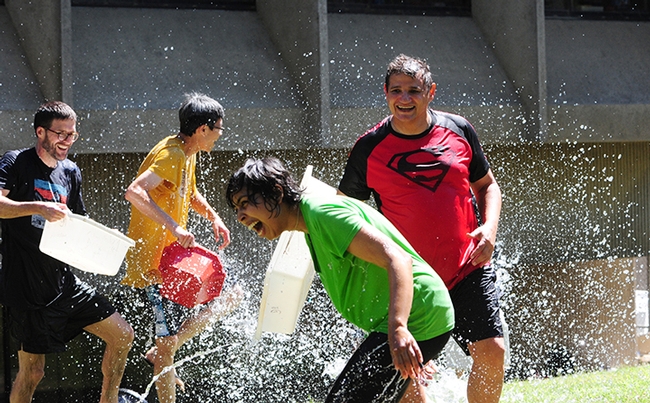
It was “fun in the sun” at the 13th annual Bruce Hammock Lab Water Balloon Battle. From left are Todd Harris and Sing Lee, assistant project scientists; graduate student Alifia Merchant who just received her master's degree in agriculture and environmental chemistry, and research scientist Christophe Morisseau, who coordinated the event. (Photo by Kathy Keatley Garvey)
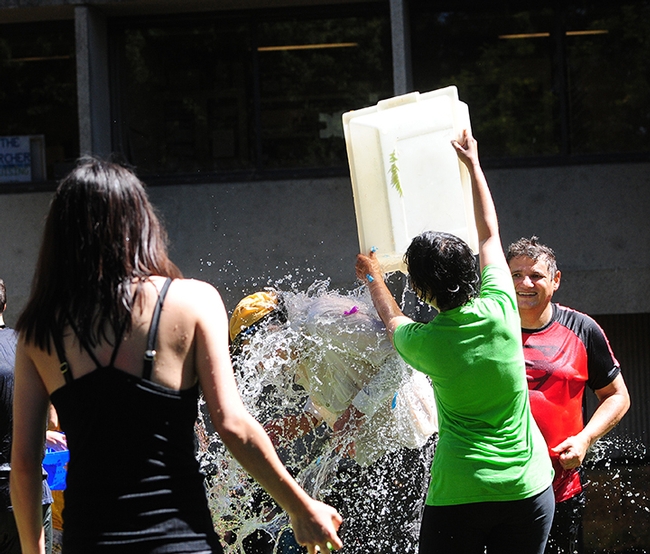
Alifia Merchant of the Hammock lab drenches Bruce Hammock. She just received her master's degree in agriculture and environmental chemistry. In the foreground is executive administrative assistant Louisa Lo. At right is Hammock lab researcher and balloon battle coordinator Christophe Morisseau. (Photos by Kathy Keatley Garvey)
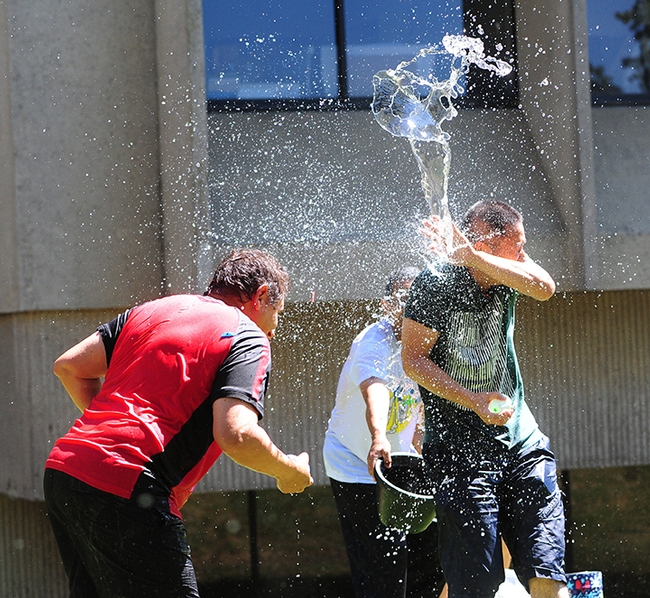
Ting Xu (far right), a visiting professor from China, gets splashed. At left is Hammock lab research scientist Christopher Morisseau. Associate professor Aldrin Gomes is in the background. (Photo by Kathy Keatley Garvey)
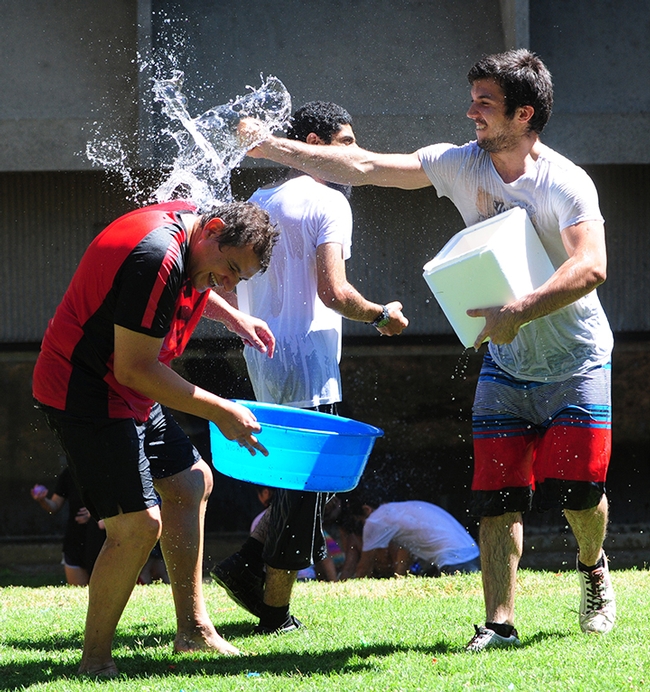
Tom Joseph, a visiting student from France (Aldrin Gomes lab) targets Christophe Morisseau of the Hammock lab. (Photo by Kathy Keatley Garvey)